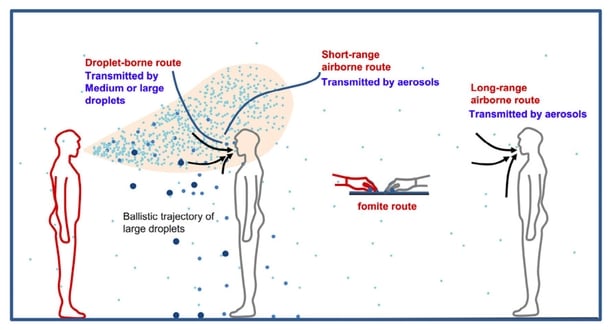Why airborne transmission of Covid-19 will increase this winter 21 Oct 2020

Analysis: we will be spending more time indoors this winter and airborne transmission means the risk of the virus spreading is even greater - Professor John Wenger, School of Chemistry and Environmental Research Institute at UCC
As we struggle to cope with a second wave of the Covid-19 pandemic in Ireland, it is essential that we do everything in our power to prevent the coronavirus (SARS-CoV-2) from spreading in our communities. We are all familiar with the public health advice, which tells us to remain two metres apart, wash hands regularly, disinfect surfaces and wear masks in certain environments.
However, there have been numerous recent reports of large outbreaks occurring despite HSE guidelines being followed at all times. These include a golf outing where at least 20 people tested positive for Covid-19 and the much-publicised case in a restaurant where four employees and six people at another table became infected.
Aside from issues with non-compliance, it is clear that the current guidelines are not sufficient in controlling the relentless spread of Covid-19 in our communities. So what are we missing?
From RTÉ Radio 1's Today With Sarah McInerney, John Wenger from UCC and Sam McConkey from the RCSI discuss airborn transmission of the virus
I am among a growing number of scientists who believe we are missing proper guidance from public health authorities on how to prevent airborne transmission of SARS-CoV-2. This mode of transmission is one of three possible ways in which the virus can be spread, but its importance has been completely downplayed by the World Health Organization (WHO) and the Centres for Disease Control and Protection (CDC) in the US and Europe. From the beginning of this pandemic, the HSE has closely followed the WHO advice and delivered public health guidance that is largely focussed on protection against the two other possible modes of transmission – the "contact" and "droplet" routes.
It is important that we have a clear picture of the physical mechanisms responsible for these different modes of transmission so that we can understand and apply the best protective measures. Transmission by the contact route can occur both directly (by touching an infected person) and indirectly (through "fomites," which are objects contaminated with the virus). Hand-washing and disinfection of surfaces is the advice given to protect against this mode of transmission.

Many have taken this to extremes with deep cleaning and the use of foggers to spray disinfectants onto surfaces, but this so-called "hygiene theatre" is largely a waste of time and valuable resources. Early studies which reported that SARS-CoV-2 can survive for hours to days on various surfaces were conducted using unrealistically high concentrations of virus and were not at all representative of environmental conditions. Consequently, evidence for fomite transmission is very scarce and the US CDC has significantly downgraded the potential role of contaminated surfaces in spreading the virus.
Transmission by the droplet route occurs when large respiratory particles expelled by coughing, sneezing and talking fly through the air and land on a nearby person's eyes, nose or mouth. Droplets larger than 100 micrometres (one tenth of a millimetre) have a ballistic, cannonball-like trajectory and typically fall to the ground in seconds and within 2 metres of the source, hence the well-known guidelines on physical distancing.
More importantly, coughing, sneezing and talking also produces thousands of much smaller respiratory particles (up to 10 micrometres in diameter) which do not fall to the ground, but remain suspended in the air as aerosols for up to several hours. Airborne transmission of the virus occurs when the aerosols produced by an infected individual are inhaled by another person.
From RTÉ Radio 1's Drivetime, Martin McKee from the the London School of Hygiene & Tropical Medicine on how Covid-19 might be spread through particles that linger in the air
Like droplets, exhaled aerosols are highly concentrated near the infected person, so most easily transmit the virus at short-range. But the virus-containing aerosols behave like smoke and can travel a lot further than 2 metres, leading to the possibility of long-range airborne transmission. This route is not expected to be important outdoors as the aerosols are rapidly diluted and dispersed.
However, airborne transmission is very important indoors, particularly in poorly ventilated spaces where levels of the virus can spread throughout the room and build up over time. Under these conditions, there is no safe distance from an infected person and all those present are at increased risk of infection.
In fact, the long-range airborne route is by far the most plausible way in which the virus is transmitted during "superspreading events", where one infected person (frequently asymptomatic) spreads the virus to many others. Some highly publicised examples of superspreading events include a choir practice in Washington State, a meat processing plant in Germany a call centre in Korea and a school in Israel. Ireland is of course not immune to these large outbreaks: many of which have occurred in residential care facilities and meat plants, but also in social gatherings.
From NHK World-Japan, new research reveals how tiny droplets carrying the virus can remain in the air for some time
Since there is now compelling evidence that large outbreaks and superspreading events are driving the pandemic, it is critical that the WHO overcomes its historical bias against aerosols and finally accepts that airborne transmission is important in the spread of SARS-CoV-2. This breakthrough would provide the HSE with the confidence to put forward new measures to specifically protect against airborne spread of the virus. These include
· Improved guidance and regulations to ensure good ventilation in our homes, schools and workplaces
· Targeted prevention of airborne transmission in specific high-risk conditions, such as meat plants, direct provision and residential care facilities
· Detailed advice on the use of supplementary methods for air cleaning and disinfection
· Mandatory wearing of face masks in workplaces, unless working alone
· A ban on using face visors instead of masks, except for medical reasons
READ: Open the windows! A guide to airing your house and Covid-19
READ: All you need to know about wearing face masks in public
We will be spending more time indoors this winter and the risk of the virus spreading is even higher. Accepting the reality of airborne transmission is now more important than ever as it will empower us to fight back stronger against Covid-19.